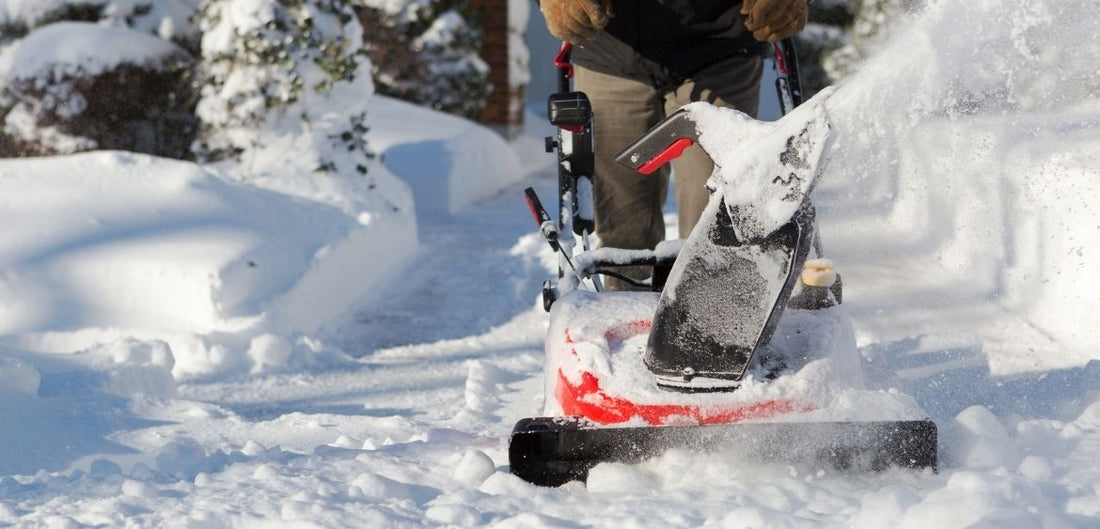Depending on where you live, it may be that time of the year when snow starts to fill your sidewalk and the front of your house, making it impossible to get anywhere without clearing a path. Using a snow blower can be the easiest, less labour intensive, option compared to picking up a shovel and spending hours working.
Although snow blowers are handy pieces of equipment, they can be made even better by actuating the chute. This would allow for the snow to be flung at varying trajectories. If your snow blower does not already have an actuated chute, do not worry – a manual chute can easily be converted. Let’s take a look at what you will need to make a snowblower chute automatic.
What You Need to Make a Snow Blower Chute Automatic
You will need the following items need to get started with actuating your snow blower’s chute:
Linear Actuator
A 12V electric actuator for a snowblowers chute rotation is the main component for this project. Since the linear actuator will be exposed to snow, it is important to use an IP-rated actuator to avoid internal damage to the componentry. Progressive Automations offer a variety of IP-rated linear actuators, but anything higher than IP54, such as the PA-14P or PA-14, would suffice. Alternatively, the PA-04 provides a superior IP66 rating, thereby, decreasing the risk of damage to the actuator due to water/snow exposure.

If you decide to opt for the 12V PA-14P, the stroke and force can be selected, ranging from 2 to 40 inches and 35 to 150 lbs, respectively. Bear in mind that it is good practice to allow the actuator to fully extend and fully retract and let the built-in limit switches dictate the total movement. The stroke length can be determined by measuring the minimum and maximum length the chute will move. For the force, 35 lbs is more than enough to automate a snow blower’s chute.
Mounting Brackets (if required)
Each linear actuator comes with its preferred mounting bracket option. For the PA-14P, the BRK-14 is the ideal choice. As shown later, a bracket may not be needed, since the mounting hole at the base of the actuator and the end of the actuating rod are both pivot points, with the actuator mounted on the one side of the chute.

Additional Washers, Bolts, and Nuts/Spacers
As mentioned in the previous point, side-mounting the linear actuator will require bolts and spacers to ensure a smooth movement.
Wiring, Connectors, and an In-Line Fuse
The AC-17 wiring kit is ideal for this application as it contains two fuse holders with a 10A fuse for over-current protection when the polarity is reversed for extending and retracting of the linear actuators rod.
Rocker Switch
The RC-03 momentary rocker switch allows for the low-cost control of the linear actuator. The switch is spring-loaded for fast and easy snowblower chute control.
12V Power Supply (battery)
The AC-03 will work with the PA-14P. However, ensure the amp-hour rating is high enough for the battery to last longer. Multiple 12V batteries can be connected in parallel to increase the amp-hour rating.

How to Automate Your Snow Blower
The installation of the linear actuator is straight forward. Without the linear actuator, the snow blower’s chute can be adjusted manually up and down, following a guided slot (shown by the thick, curved line in the illustration below). The pivot and mounting points are indicated in red on the illustration. The two mounting points on the linear actuator, in its fully retracted and extended positions, can be measured to determine the correct stroke for the PA-14P.

Since the linear actuator is going to be installed on the side of the chute, spacers on the bolts will be needed to ensure a parallel alignment with the side of the chute. Both mounting points should pivot freely to avoid unnecessary strain on the actuator. Ensure the rod’s mounting point is located away from the chute’s main pivot point to create a larger moment arm and less force on the actuator.
Before moving on to the wiring, attach a 12V supply directly to the linear actuators leads to test the extension of the rod and then switch the polarity to test the retraction. If the actuator moves as it should, hitting both internal limit switches, then the installation is successful.
Wiring
Wiring the rocker switch to the linear actuator will allow for easy positioning of the chute. Using the cables and Molex connectors from the AC-17 kit, connect the two wires from the linear actuator to pins T2 and T3 on the rocker switch. It does not matter which way around they are attached.
Thereafter, one end of the in-line fuse attaches to T1 and the other end to T6. A jumper cable from T6 will be needed to attach to the positive terminal on the 12V power supply. Repeat the same process with the second in-line fuse except from T3 to T4 and a jumper cable from T3 to the negative terminal on the power supply. See the schematic below.

The above configuration will allow the linear actuator to extend when the rocker switch is pushed one way and when pushed the other way, the polarity will reverse and retract the actuator. The fuses protect the actuator from over-current in both directions. Test the rocker switch to ensure the linear actuator can retract and extend.
The final step is to place the switch and its cabling into an enclosure (including the in-line fuses). Ensure all exposed terminals or cabling are covered with electrical tape or heat shrink tubing to avoid short-circuits. Additionally, secure the cables on the snow blower leading to the linear actuator while leaving some slack to avoid excessive strain on the cables.
Conclusion
Now that you have learnt how to make a snowblower chute automatic to change the trajectory of snow that is flung out, why not see what else you can automate to handle the mounds of snow you need to get rid of this winter? For example, you could use a linear actuator for further snowblower chute control by rotating the whole chute using the same wiring as described previously, just connected the actuator in a different configuration. Why not automate the front of your snow blower as described in our other article?
Progressive Automations provides all the necessary linear actuation technology to make your automation project run smoothly. For more information on Progressive Automations products or for additional support, contact us today.




